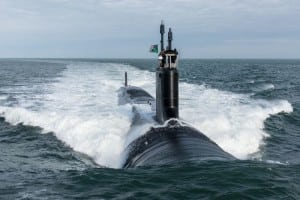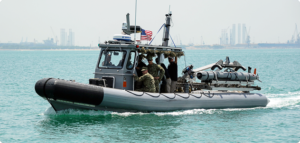Navy officials this week said they are working on developing medium unmanned undersea vehicles (MUUVs) that can be be launched and recovered from submarine torpedo tubes, making submarines motherships.
The Navy is “really focused on the torpedo tube launch and recovered variant Razorback,” to avoid the overhead for the current method of using limited numbers of dry deck shelters, Rear Adm. Doug Perry, director of Undersea Warfare, said Tuesday during the Naval Submarine League’s annual symposium.

Perry noted the Navy has been testing a Razorback with submarines for some time, but the current method requires 30 divers and Navy SEALs to launch and recover UUVs with a limited number of dry deck shelters.
“So the transition for torpedo tube launch and recovery is huge. We’ve got 200 torpedo tubes in the fleet, we want to leverage as many of those as possible across our platforms to get down to the ocean floor as necessary,” he said.
The Razorback is based on the REMUS 600 UUV built by HII [HII].
Vice Adm. Bill Houston, commander of submarine force, U.S. Atlantic Fleet Commander, and Allied Submarine Command, emphasized “the thing that we are pushing the most is that we are pushing medium UUV torpedo tube launch and recovery. That is one of our biggest focuses.”
Speaking to reporters on the sideline of the symposium, Houston added that while the magazine capacity of a submarine is lethal, “the number of torpedoes we carry are limited. And so every UUV we carry – if we launched it and we didn’t recover it, that would take the place of a torpedo. And if we can reuse that UUV, then we save torpedoes.”
Houston said a UUV based on a submarine like this would serve various missions, akin to unmanned aerial vehicles.
“It can serve as a scout, do missions that you do not want the manned platform to do. So essentially, we can go out and we can use these UUVs to scan, search, do other things for us, come back to the submarine. And we’re not using a tremendous number of torpedo stoves for that, because if you can recover it, you can use it again.”
Houston said software and systems to recover the MUUV are the key sticking points.
“We have no problem launching UUVs. That’s easy. The recovery part has been the critical aspect. We have two initiatives and we have a lot success with it right now. And we think we will have something operational in the not too distant future,” Houston added during his official remarks.
He told reporters the recovery is very complex because they have to account for the submarine and MUUV moving as well as a sea current pushing against both.

“You can imagine something the size of a torpedo with very tight tolerances driving through a moving tube in complete pitch blackness. So perfectly bullseye a moving target with cross current. I will say the equivalent is basically having a space shuttle or space object link with the International Space Station,” but also adding the sea current.
He said this is largely a software, algorithm and UUV design issue “to be able to reliably and safely drive it into a torpedo tube. And then to get a bullseye every single time.”
However, Houston said the Navy has “ world class organizations” working to solve the issue “and we have had great success, and we’re ready to do our final demos coming up.”
He did not disclose when the demonstrations will occur.
On November 2, Rear Adm. Casey Moton, program executive officer for Unmanned and Small Combatants, reiterated the MUUV effort is developing systems based on a single UUV design for both this submarine use and the explosive ordnance disposal (EOD) mission.
He boasted “this is no small task but an extremely innovative approach. And UUV is off to a great start” with Leidos [LDOS] and partner L3Harris Technologies [LHX].
The companies were chosen earlier this year to develop and build the new MUUV joint acquisition venture. In July the Navy picked Leidos over three other competitors for a $12 million contract to design the MUUV, with options up to $358 million (Defense Daily, July 8).
MUUV is planned to consist of a single common baseline architecture for sensors and components, but is divided into the Razorback torpedo tube launch and recovery variant and Maritime Expeditionary Mine Countermeasures UUV (MEMUUV), that will be called the Viperfish MUUV. Viperfish is focused on surface-launched and recovered mine countermeasures.
Moton said the MUUV program recently finished an integrated baseline review and is about to execute the first major milestone in the systems engineering review, the system requirements review and system functional review.
“When this game changing capability is deployed, every SSN will have the ability to serve as a UUV mothership,” Moton added.
Houston noted after the Navy and contractors figure out the solution, the “special proprietary software” will not be tied to a specific platform.
“Once you get the software right it’s going to be applicable to any of them.”